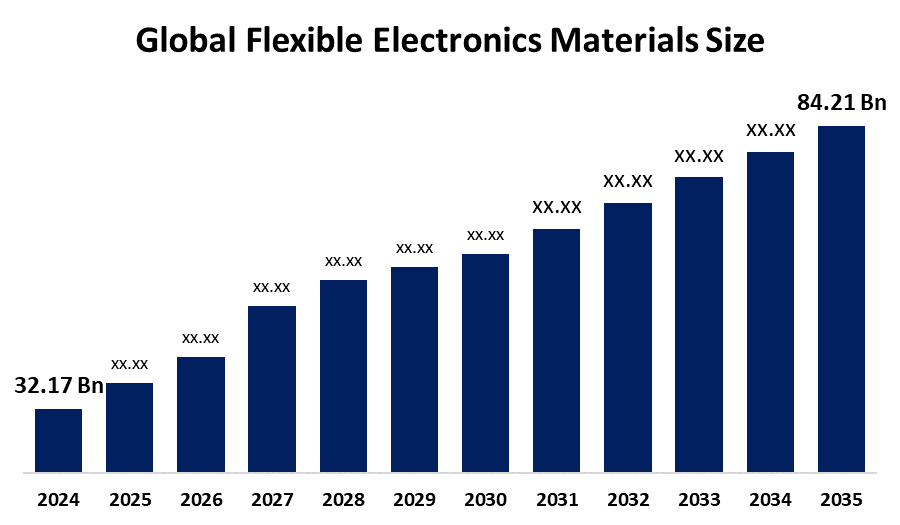
Top 50 Companies in Flexible Electronics Materials Market: Expert View By Spherical Insights
RELEASE DATE: Sep 2025 Author: Spherical InsightsRequest Free Sample Speak to Analyst
Description
According to a research report published by Spherical Insights & Consulting, The Global Flexible Electronics Materials Market Size is projected To Grow from USD 32.17 Billion in 2024 to USD 84.21 Billion by 2035, at a CAGR of 9.14% during the forecast period 2025–2035. The market is developing favorably as a result of the growing sales of Internet of Things (IoT) devices worldwide. The market for flexible electronics is anticipated to be driven by consumers' increasing need for small and cutting-edge smart consumer gadgets worldwide. Furthermore, the market is expanding favorably due to the quickly expanding printed electronics industry.
Introduction
Flexible Electronics Materal Market Size are becoming more and more popular in the market because of their stretchable and flexible qualities. It may be used on a variety of substrates, including paper, plastics, and flex glass, due to its flexibility. Global demand for flexible electronics is being driven by the growing need for a variety of specially designed consumer and industrial products, as well as the increased use of novel materials in consumer goods production. The market expansion for flexible electronics is being aided by the rising demand for various wearable devices. Flexible electronics have become increasingly popular in the production of wearable technology worldwide due to their capacity to conform to different shapes.
Navigate Future Markets with Confidence: Insights from Spherical Insights LLP
The insights presented in this blog are derived from comprehensive market research conducted by Spherical Insights LLP, a trusted advisory partner to leading global enterprises. Backed by in-depth data analysis, expert forecasting, and industry-specific intelligence, our reports empower decision-makers to identify strategic growth opportunities in fast-evolving sectors. Clients seeking detailed market segmentation, competitive landscapes, regional outlooks, and future investment trends will find immense value in the full report. By leveraging our research, businesses can make informed decisions, gain a competitive edge, and stay ahead in the transition toward sustainable and profitable solutions.
Unlock exclusive market insights - Download the Brochure now and dive deeper into the future of the Flexible Electronics Materials Market.
Flexible Electronics Materials Market Size & Statistics
- The Market Size for Flexible Electronics Materials Was Estimated to be worth USD 32.17 Billion in 2024.
- The Market Size is Going to Expand at a CAGR of 9.14% between 2025 and 2035.
- The Global Flexible Electronics Materials Market Size is anticipated to reach USD 84.21 Billion by 2035.
- North America is expected to generate the highest demand during the forecast period in the Flexible Electronics Materials Market
- Asia Pacific is expected to grow the fastest during the forecast period in the Flexible Electronics Materials Market.

Regional growth and demand
Asia Pacific is expected to grow the fastest during the forecast period in the flexible electronics materials market. This is a result of the area being home to several leading producers of consumer electronics. Flexible electronics usage is increasing as a result of the increased need for a variety of reasonably priced consumer electronics items. Furthermore, because the region has inexpensive production inputs, the government's increased efforts are drawing foreign direct investments (FDIs) and making it easier for other vertical participants to establish their manufacturing facilities in countries like China, India, and Indonesia. Thus, it is anticipated that the Asia Pacific flexible electronics market will expand quickly over the next several years.
North America is expected to generate the highest demand during the forecast period in the flexible electronics materials market. The market's expansion has been greatly aided by the region's growing use of flexible electronics in consumer, automotive, healthcare, and military applications. The need for flexible electronics has increased as a result of the region's greater need for innovative technology.
Top 5 trends in the Flexible Electronics Materials Market
- Growing Demand for Wearable and Smart Devices
- Advancements in Flexible Substrate and Conductive Materials
- Rise of Foldable and Rollable Display Technologies
- Integration of AI and Machine Learning in Manufacturing
- Expansion of Flexible Electronics in Healthcare and IoT
1. Growing Demand for Wearable and Smart Devices
The increasing adoption of wearable technology, fitness trackers, and smart clothing drives demand for flexible electronics materials that are lightweight, stretchable, and durable. These materials enable continuous health monitoring and enhance user comfort, fueling market growth and innovation in flexible electronics.
2. Advancements in Flexible Substrate and Conductive Materials
Technological progress in flexible substrates like polyimide and conductive inks using silver nanowires and graphene improves device performance and durability. These innovations enable more reliable, bendable, and stretchable electronics suitable for diverse applications such as consumer electronics and automotive.
3. Rise of Foldable and Rollable Display Technologies
Foldable smartphones, rollable TVs, and flexible OLED displays are increasingly gaining market acceptance, pioneering new device form factors. Flexible electronics materials facilitate this revolution by providing robustness and flexibility, pushing the adoption of these novel displays.
4. Integration of AI and Machine Learning in Manufacturing
AI-driven design and inspection tools optimize flexible electronics production, reducing defects and accelerating time-to-market. Machine learning aids in discovering new conductive materials and substrates, enhancing their electrical and mechanical properties
5. Expansion of Flexible Electronics in Healthcare and IoT
Flexible electronics materials are critical in developing conformal sensors, medical patches, and smart IoT devices that require adaptability to diverse surfaces. This trend expands the market as industry adoption rises in personalized medicine, environmental monitoring, and smart infrastructure.
6. Empower your strategic planning:
Stay informed with the latest industry insights and market trends to identify new opportunities and drive growth in the flexible electronics materials market. To explore more in-depth trends, insights, and forecasts, please refer to our detailed report
Top 25 Companies Leading the Flexible electronics materials Market
- DuPont de Nemours, Inc.
- Covestro AG
- Applied Materials, Inc.
- Flex
- Polyera Corporation
- 3M Company
- Henkel AG & Co. KGaA
- Avery Dennison Corporation
- Toray Industries, Inc.
- BASF SE
- Samsung SDI Co., Ltd.
- LG Chem Ltd.
- Solvay S.A.
- Dow Inc.
- Eastman Chemical Company
- Heraeus Holding GmbH
- Sumitomo Chemical Co., Ltd.
- Johnson Matthey
- SKC Co., Ltd.
- Nitto Denko Corporation
- Hitachi Chemical Company, Ltd.
- Wacker Chemie AG
- Koninklijke DSM N.V.
- Mitsui Chemicals, Inc.
- Samsung Display Co. Ltd
1. DuPont de Nemours, Inc. (Headquarters: Wilmington, Delaware, USA)
DuPont is a global leader in advanced materials for flexible electronics, offering a comprehensive portfolio of conductive inks, flexible substrates, and encapsulation materials that enable bendable and stretchable devices. Their materials support diverse applications such as wearable sensors, flexible displays, and printed circuits. With strong R&D, DuPont continuously innovates to improve performance, durability, and environmental sustainability of flexible electronics materials. The company's solutions aid manufacturers in overcoming technical challenges like flexibility, conductivity, and adhesion, driving widespread adoption across consumer electronics, healthcare, and industrial IoT markets. DuPont's extensive manufacturing capabilities and global reach position it as a key player in the evolving flexible electronics materials sector.
2. Covestro AG (Headquarters: Leverkusen, Germany)
Covestro specializes in high-performance polymers and advanced flexible substrates vital for the flexible electronics market. Their innovative materials offer excellent mechanical flexibility, optical clarity, and thermal stability, tailored for flexible printed circuit boards, foldable displays, and wearable devices. Covestro’s continuous focus on sustainability and circular economy drives the development of recyclable and low-emission flexible materials. Collaborations with electronics manufacturers and research institutes bolster its expertise in next-generation flexible electronics materials. Covestro’s global footprint and strong material science base secure its leadership in delivering robust, eco-friendly solutions for diverse flexible electronics applications.
3. Applied Materials, Inc. (Headquarters: Santa Clara, California, USA)
Applied Materials is a major supplier of materials engineering solutions pivotal for producing flexible electronics, including thin-film deposition technologies and advanced substrate materials. Their contributions enable manufacturers to produce flexible displays, solar cells, and wearable electronics with enhanced performance and longevity. By integrating AI and automation in manufacturing processes, Applied Materials optimizes material usage and device yields. Their advanced materials and process technologies are instrumental in addressing the challenges of flexible electronics fabrication, such as mechanical stress and electrical reliability. Applied Materials’ innovation and scale position it prominently within the flexible electronics materials market ecosystem.
4. Flex (Headquarters: Singapore)
Flex is a significant player in flexible electronics by providing design, manufacturing, and materials sourcing services essential to flexible devices’ production. The company supports development in wearable technology, medical devices, and flexible displays by integrating flexible substrates, conductive inks, and encapsulation materials into scalable manufacturing processes. Flex’s broad capabilities allow rapid prototyping and high-volume production, accelerating time-to-market for flexible electronics innovations. Its partnerships with material suppliers and continuous investment in advanced materials ensure high-quality and reliable flexible electronic products globally. Flex is recognized for its commitment to sustainability and technological leadership in the flexible materials supply chain.
5. Polyera Corporation (Headquarters: Skokie, Illinois, USA)
Polyera Corporation focuses on developing next-generation flexible electronics materials, including organic semiconductors, flexible thin films, and printable conductive polymers. Their innovative materials enable ultra-thin, lightweight, and stretchable electronic components suitable for flexible displays, sensors, and wearable health monitors. Polyera’s platform technology supports scalable manufacturing compatible with roll-to-roll processes, reducing costs and expanding application possibilities. The company’s R&D emphasis on material robustness and environmental stability addresses industry challenges in durability and performance. Polyera’s cutting-edge materials and strategic collaborations position it as a pioneering contributor to advancements in the flexible electronics materials market.
Are you ready to discover more about the flexible electronics materials market?
The report provides an in-depth analysis of the leading companies operating in the global flexible electronics materials market. It includes a comparative assessment based on their product portfolios, business overviews, geographical footprint, strategic initiatives, market segment share, and SWOT analysis. Each company is profiled using a standardized format that includes:
Company Profiles
- DuPont de Nemours, Inc.
- Business Overview
- Company Snapshot
- Products Overview
- Company Market Share Analysis
- Company Coverage Portfolio
- Financial Analysis
- Recent Developments
- Merger and Acquisitions
- SWOT Analysis
- Covestro AG
- Applied Materials, Inc.
- Flex
- Polyera Corporation
- 3M Company
- Henkel AG & Co. KGaA
- Avery Dennison Corporation
- Toray Industries, Inc.
- Others.
Conclusion
The Flexible Electronics Materials Market Size is rapidly evolving, driven by innovation and expanding applications across sectors such as consumer electronics, healthcare, automotive, and IoT. Industry leaders are advancing materials that enable enhanced flexibility, durability, and functionality, responding to growing demand for wearable devices, foldable displays, and smart sensors. The market growth is also supported by technological breakthroughs in substrates, conductive inks, and manufacturing processes that improve device performance and cost efficiency. Companies emphasize sustainability alongside performance, developing recyclable and environmentally friendly materials.
About the Spherical Insights & Consulting
Spherical Insights & Consulting is a market research and consulting firm which provides actionable market research study, quantitative forecasting and trends analysis provides forward-looking insight especially designed for decision makers and aids ROI.
Which is catering to different industry such as financial sectors, industrial sectors, government organizations, universities, non-profits and corporations. The company's mission is to work with businesses to achieve business objectives and maintain strategic improvements.
CONTACT US:
For More Information on Your Target Market, Please Contact Us Below:
Phone: +1 303 800 4326 (the U.S.)
Phone: +91 90289 24100 (APAC)
Email: inquiry@sphericalinsights.com, sales@sphericalinsights.com
Contact Us: https://www.sphericalinsights.com/contact-us
Need help to buy this report?